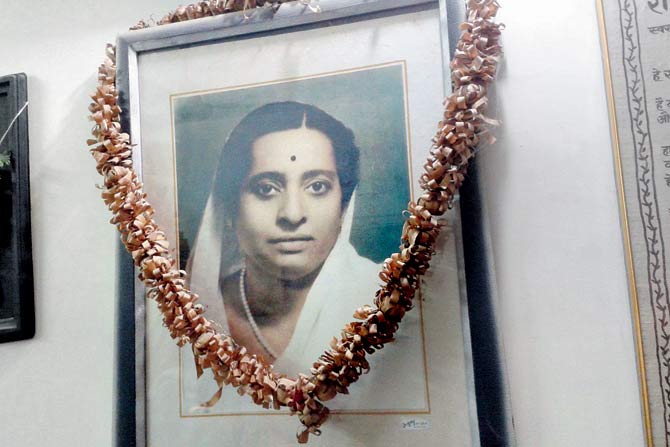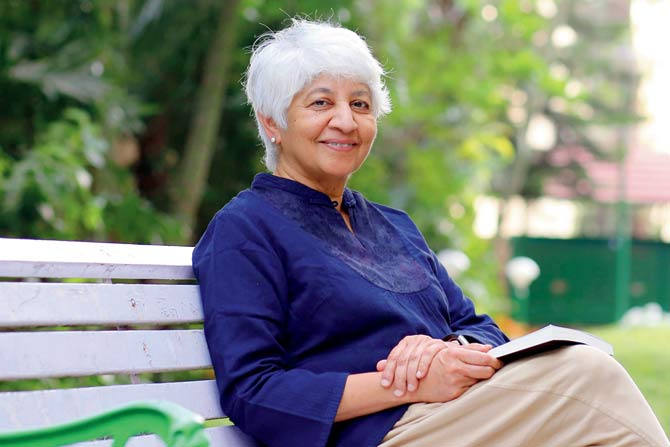Writer-scholar Tejaswini Niranjana-s new book delves into the musical madness that gripped Bombay in the 19th century. And the devadasis and tawaifs have a lot to be thanked for

The new image of the "naikin and tawaif"�a contemporary take on the original 20th century postcard picture�was prepared for Tejaswini Niranjanas 2015 exhibition Making Music-Making Space. It has the women turning away from each other, suspended
An early 20th-century postcard, photographed in Bombay and printed in Luxembourg, now part of the colonial circulation of images of Indians, shows two women standing sideways, facing each other, "exchanging notes". One, in her short kameez-churidar and an arm akimbo, while the other, wrapped in a sari, wearing a nath and huge bindi on her small, round face. "I imagine them to be a devadasi or naikin [the latter] and a tawaif. I also imagine that they lived near Kennedy Bridge in the Grant Road-Lamington Road area, where so many from their communities made a home in Bombay," says author and academician Tejaswini Niranjana.
ADVERTISEMENT
The naikin from Goa in western India and the tawaif from northern India are part of the influx of performers into the city-s entertainment industry from the 1860s onwards. Both, says Niranjana, had an intimate connection to Hindustani music. They also played an instrumental role in perpetuating their art in Bombay city, giving rise to a musicophilia that caught the collective imagination of its residents.
Niranjana-s newly released book, Musicophilia in Mumbai: Performing subjects and the Metropolitan Unconscious Duke University Press, is the result of a nearly decade-long research in understanding this phenomenon.
Split into five chapters, the book traces the role of Hindustani classical music in the evolution of the city of Mumbai, during the British colonial period and after Independence, and examines the people who fell madly in love with this music—the musicophiliacs or deewaane, as Niranjana calls them. "You cannot have a rational explanation for this devotion [to music], which gripped the newly urban inhabitants of Mumbai in the mid to late 19th century," says Niranjana, who learned classical music from the famous exponent of the Gwalior gharana, Neela Bhagwat. "I focus on them. Who were they, where did they come from, how did their aspirations in the modern city of Mumbai become linked to the appreciation of Hindustani music, where did Mumbai people get exposed to this music, what might have been their experience of collective listening?," she adds, in an email interview.
 A A framed photograph of Kesarbai Kerkar in her disciple Dhondutai Kulkarni-s house
A A framed photograph of Kesarbai Kerkar in her disciple Dhondutai Kulkarni-s house
What Niranjana found most intriguing is that given the time period—when Indians were becoming part of the modern world and creating their own modernity—it seemed strange that these city dwellers, some of whom were reputed physicians, lawyers and engineers, could have been obsessed with this, so-called, -old time- music. While there could be no clear answer to this, Niranjana says that one of the reasons could be the "need to connect to something from the past even as they created new lives in the modern city".
In 2011, Niranjana contacted documentary film director Surabhi Sharma, asking if she would like to put together a joint research proposal. "We planned to submit it to the Heritage Conservation Society of the MMRDA, with the claim that Hindustani music was an important part of the intangible heritage of Mumbai. Our aim was to explore the spaces that music occupied in the city over the 20th century," she says. "Since we were a scholar-filmmaker duo, it was inevitable that at some point a film and a book would emerge out of the collaboration," she adds. Sharma-s film, Phir Se Samm Pe Aana Returning to the first beat, was premiered at MAMI in 2017. Niranjana-s book is an extension of the same research.
As she delves into how Hindustani music moved from being a courtly art to one firmly embedded in the urban marketplace, we also get a sense of the forgotten female artistes who enthralled these musicophilacs. While Niranjana insists that the book focuses only on the latter, their journey into the city-s music scene, is crucial too. "The devadasis who came to Mumbai from Goa wanted to learn music from the ustads. By acquiring patrons among the city-s merchants, they affiliated themselves to wealthy men who could afford to pay the ustad-s fees. Examples of such women who became famous singers are Mogubai Kurdikar and Kesarbai Kerkar, who both studied with Alladiya Khan. The devadasi, rendered respectable through absorption into the middle or upper classes, could be acknowledged by the ustad as a pupil," says Niranjana, a professor of cultural studies at Lingnan University, Hong Kong. The tawaifs, she says, were part of a different history. They came to Mumbai around the same time as the ustads and other performers, with the decline of Awadh after 1857 and the crumbling of the remnants of the Mughal empire. "The tawaif remained in the kotha, fromwhere she provided support for rising male musicians, but did not emerge onto the concert stage."
 Pic /Ajeesh F Rawther
Pic /Ajeesh F Rawther
Girgaum is central to Niranjana-s research. The rise in patrons, in the 19th century, also saw the growth of newer structures of patronage for performers. "Girgaum was also marked by a density of population, where most Mumbaikars lived at the time. The institutions relevant to music were there too: the music schools, theauditoriums/concert halls, the shops that sold musical instruments, records, and gramophones," says Niranjana. "In fact, listeners employed runners to tell them which musician was reaching the height of his performance in a particular concert hall, and they streamed in and out of halls based on this information." The neighbourhood, she says, remained a crucial location for Hindustani music until the 1980s, when both musicians and audiences began to relocate to less crowded parts of the city.
The musicophilia, however, continues and is still very much part of the city-s cultural scape. "Concert halls still fill up for performers on a weekly basis. Countless young people are learning Hindustani music. The forms of pedagogy are changing, with cyber-teaching becoming quite popular among those who don-t live in the city, but the seriousness of engagement with music is still quite widespread," she says.
Catch up on all the latest Mumbai news, crime news, current affairs, and also a complete guide on Mumbai from food to things to do and events across the city here. Also download the new mid-day Android and iOS apps to get latest updates
 Subscribe today by clicking the link and stay updated with the latest news!" Click here!
Subscribe today by clicking the link and stay updated with the latest news!" Click here!






